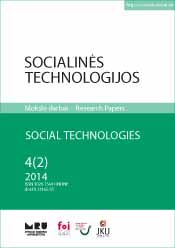KŪRYBIŠKUMO SKATINIMAS PER ŽAIDYBINIMĄ PAGAL ŽAIDĖJŲ TIPUS
GAMIFICATION IN FOSTERING CREATIVITY: PLAYER TYPE APROACH
Author(s): Marius KalinauskasSubject(s): Social Sciences
Published by: Mykolas Romeris University
Keywords: gamification; creativity; collective creativity; player types.
Summary/Abstract: Purpose – to analyze gamification, as the method for promoting creativity in individual and collective levels with the respect to player types. Design/methodology/approach – This research serves as a general review/viewpoint which seeks to examine collective creativity as a phenomenon and gamification as the tool for promoting individual and collective creativity. The paper is based on the comparative analysis of scientific literature and related sources from game design, psychology, business and entertainment. Findings – Although the gamification is gaining more public attention, there is a lack of studies which would reveal its relations in fostering individual and collective creativity. One of the main goals of any gamified content is to raise the engagement into activities in non-game contexts. The objective of creative work is to come up with some ideas, methods or tools which would be significantly new and innovative in the case of a certain issue. The theory of “flow” is used widely in explaining the working principles of gamification. In this state, the information absorption rates are increased and the group or individual is immersed into performed activities. This may lead to prolonged periods while accumulating knowledge, and thus, improving creative capabilities in the specific domain. However, creative performance in different fields has various approaches. It is also related to personal characteristics. The success of gamification is also dependent on the types of “players” which participate in the activity. Having the common picture of personality type in creative performance and in game based tasks may allow creating gamification strategy for optimal engagement into creative work according to the features of a person. Research limitations/implications – There are very few empirical studies which would support correlation between experiencing the “flow” state and a raise of creativity. The idea of unified personality model for game and non-game contexts is purely theoretical and would require empirical evidence in the future research. Practical implications – Knowing how to apply game mechanics elements for specific groups of creative workers may increase their engagement and performance rates in collective and individual creativity. Value – The article emphasizes theoretical analysis of gamification and its applicability in promoting individual and collective creativity based on player/personality types. This area of research is rather new and there are very few attempts to create a unified personality and gamer type model. Gamification is working by providing different experiences to players and stimulating their intrinsic and extrinsic motivation to perform their activities with greater engagement.
Journal: Socialinės Technologijos
- Issue Year: 4/2014
- Issue No: 02
- Page Range: 385-400
- Page Count: 16
- Language: Lithuanian

